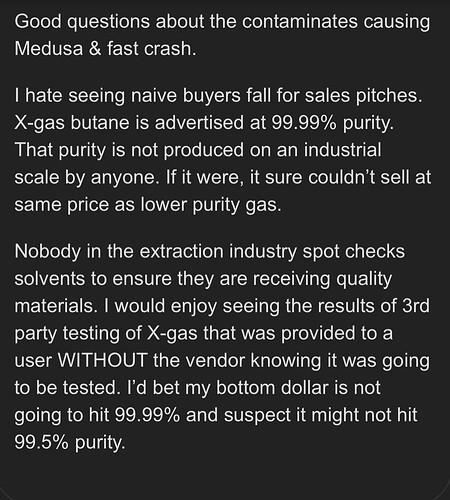That seems really weird to me. We have accepted limits for impurities in just about everything. And I mean everything.
Why are you trying to treat the cannabis industry like its different from all other consumer product industries that have acceptable limits for impurities?
There is nothing out there that is 100% of anything and most things don’t even get close. Controlling for the types and kinds of impurities is important - but acting like they should never exist is really far from the reality of production around the globe.
We’re way better at it today than we were 50 years ago and there’s still impurities everywhere. And we’re better at keeping them out of all kinds of stuff than we have been for centuries and there’s still impurities everywhere.
You’re operation probably adds more impurities from product contact surfaces and interactions with materials of construction.
Its okay for us to have standards and we should but the standard needs to be reasonable and everyone needs to agree on it. <3
I 100% hope you’ll be joining us in Denver in June for the ASTM conference that will talk about things like this. Standards for impurities in materials being used in our industry. I talk to other people about these things all the time - some people don’t care at all! And some people, like you, think there should never be impurities.
The truth is somewhere in the middle and we have to agree as an industry on what kind of methods are possible to prevent downstream issues, costs involved with upstream and downstream controls, potential risks to consumers, potential risks to employees/operators, and then all arrive at a solution together.
Lucky for us - we get to be involved in the process for saying what the limits of detection and quantitation MUST BE for someone to say something is ND. And we get to be involved in the process for defining which impurities must be checked for.
Hell - 10 years ago no one checked to see if there was butane or propane left over in concentrates. And now we check those down to the ppm. Maybe in the future we’ll check them to the ppb (I mean you seem to be implying we should be checking them beyond current technology…but who knows where technology will take us!)
Are you planning to come to Denver for the conference discussing this stuff? Cause I’m gonna be there and we need more voices from people who actually do this work. Cause there are plenty of people that will be there that have never created a concentrate, or consumed one… and are suppliers of packaging components or tanks or batteries or something.
We need more - us. <3

